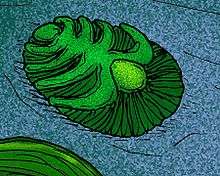Praecambridium
Praecambridium sigillum is an extinct organism that superficially resembles a segmented trilobite-like arthropod.[1] It was originally described as being a trilobite-like arthropod, though the majority of experts now place it within the Proarticulata as a close relative of the much larger Yorgia.[2][3] It is from the Late Ediacaran deposit of Ediacara Hills, Australia, about 555 million years ago. On average, P. sigillum had at least 5 pairs of segments, with each unit becoming progressively larger as they approach the cephalon-like head.
| Praecambridium sigillum Temporal range: Ediacaran | |
|---|---|
 | |
| Scientific classification | |
| Kingdom: | Animalia |
| Phylum: | †Proarticulata |
| Class: | †Cephalozoa |
| Family: | †Yorgiidae |
| Genus: | †Praecambridium Glaessner & Wade, 1966 |
| Species: | †P. sigillum |
| Binomial name | |
| †Praecambridium sigillum Glaessner and Wade, 1966 | |
Etymology
The generic name is a compound word, with the Latin prefix prae "before" and a reference to the Cambrian mollusc genus Cambridium, in reference to how the appearance of the various segments are reminiscent of the muscle-scars on the inner surface of the shells of Cambridium.[4] The specific name is from Latin sigillum "a sigil".
See also
References
- Glaessner, M.F.; Wade, M. (1971). "Praecambridium – a primitive arthropoda". Lethaia. 4 (1): 71–77. doi:10.1111/j.1502-3931.1971.tb01280.x.
- Ivantsov, Andrey Yu. (2007). "Small Vendian transversely Articulated fossils". Paleontological Journal. 41 (2): 113–122. doi:10.1134/S0031030107020013.
- Ivantsov, A.Y. (2001). "Vendia and Other Precambrian "Arthropods"". Paleontological Journal. 35 (4): 335–343.
- Glaessner, M.F.; Wade, M. (1966). "The late Precambrian fossils from Ediacara, South Australia" (PDF). Palaeontology. 9 (4): 599–628. Archived from the original (PDF) on 2015-06-13. Retrieved 2015-06-11.